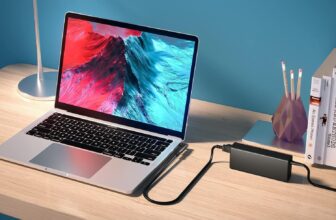Table of Contents
How do you choose the best IPS LED monitor in 2025? What features and functions the best IPS LED monitor should have to suit your needs. Read the full article to find out.
What are the advantages of an IPS LED monitor?
 The main advantages of IPS (In-Plane Switching) monitors are much broader viewing angles than TN monitors and much more accurate reproduction of black and colour in darker images.
The main advantages of IPS (In-Plane Switching) monitors are much broader viewing angles than TN monitors and much more accurate reproduction of black and colour in darker images.
Perhaps larger viewing angles do not matter too much, as you usually stand right in front of the monitor, but accurate colour reproduction provides an enormous difference when you work, watch a movie or play.
IPS monitors have immediately become favourites of photographers and graphic artists for whom colour reproduction as close to reality as is very important, but ordinary users initially had 2 problems with IPS monitors: higher price and lower response time.
Although P-IPS (Professional IPS) monitors are still very expensive, the introduction of e-IPS (enhanced IPS) technology has greatly reduced the prices for other models.
The response time is still weaker in IPS monitors than TN-film, but it is not noticeable so easily in smaller screens of regular monitors. Many IPS monitors use Free Trace technology that reduces the ghosting effect.
Also, IPS technology minimizes the so-called “input lag” – the response time between the click of the mouse and the result displayed on the screen. This is especially important when playing a FPS or any other high frame rate game.
Top 3 Recommended Best IPS LED Monitors
Comparison of LCD technologies
 To give you an idea of the current technologies used in monitor screens, we have a brief comparison below.
To give you an idea of the current technologies used in monitor screens, we have a brief comparison below.
- TN (Twisted Nematic) – Cheapest. Excellent response time. Narrow viewing angles. Can not reproduce all colours in the RGB spectrum.
- IPS (In-Plane Switching) – The most realistic colors. Black levels less deep than VA monitors. Wide viewing angles. Higher response time. The p-IPS monitors are very expensive, while e-IPSs are not as good at color reproduction.
- PLS (Plane-to-Line Switching) – A version of Samsung’s IPS technology.
- VA (Vertical Alignment) – Angles of viewing and color reproduction much better than TN-film, but with a longer response time. The best technology for black shades.
The Best IPS LED Monitor: What to Look for
IPS, or In-Plane Switching, and LED, or Light Emitting Diodes, are terms that have become commonplace in the monitor industry, promising improved viewing angles, better colour accuracy and lower energy consumption.
Here are some factors to consider when selecting the best IPS LED monitor for your needs.
Screen Size and Resolution of the IPS LED monitor
First things first, the monitor’s size and resolution will significantly impact your viewing experience. Size is mostly a personal preference and depends on how much desk space you have. Monitors typically range from 21 to 32 inches, with some going up to 49 inches.
Screen Size
The screen size of a monitor is measured diagonally, from one corner of the screen to the opposite corner, usually in inches. The right size for you largely depends on what you’re using the monitor for and how much space you have.
For general computing tasks like browsing the web or using office software, a 21 to 24-inch monitor will likely suffice. If you’re into gaming, a 24 to 27-inch monitor is often considered the sweet spot, offering enough screen real estate without forcing you to move your eyes or head excessively.
 If you’re a professional in fields like video editing, 3D modelling, or graphic design, or if you like to have multiple windows open simultaneously, a larger monitor (27 inches or above) can be incredibly beneficial. Ultra-wide monitors, which are even wider than regular widescreen monitors, can further enhance productivity by replacing dual-monitor setups with a single, seamless display.
If you’re a professional in fields like video editing, 3D modelling, or graphic design, or if you like to have multiple windows open simultaneously, a larger monitor (27 inches or above) can be incredibly beneficial. Ultra-wide monitors, which are even wider than regular widescreen monitors, can further enhance productivity by replacing dual-monitor setups with a single, seamless display.
Remember, though, that a larger monitor will take up more desk space and, depending on the resolution, may require more powerful hardware to take full advantage of.
Resolution
Resolution refers to the number of distinct pixels that can be displayed on a screen and is usually represented as the number of pixels on the horizontal axis (width) by the number of pixels on the vertical axis (height).
For instance, Full HD resolution, which stands at 1920 x 1080 pixels, is the standard for many monitors today and offers a clear, sharp image for general use and gaming. This resolution on a 24-inch monitor results in a pixel density of about 92 pixels per inch (PPI), which is sufficient for most tasks.
However, if you’re involved in work that requires a higher level of detail, such as photo editing or CAD work, or if you simply want a more immersive viewing or gaming experience, you might opt for a higher resolution.
2K or QHD (Quad High Definition, 2560 x 1440 pixels) monitors provide a noticeable increase in sharpness and detail over Full HD. 4K or UHD (Ultra High Definition, 3840 x 2160 pixels) monitors take this a step further, offering incredibly detailed and sharp images, but keep in mind that you’ll need a potent graphics card to run games or other graphically intensive tasks at this resolution.
It’s essential to strike a balance between screen size and resolution. A larger monitor with low resolution can result in a pixelated image, while a high resolution on a small monitor might make everything look too small, causing you to squint or zoom in excessively.
Lastly, consider the scaling capabilities of your operating system if you’re thinking about high resolutions. Some operating systems handle scaling better than others, making text, icons, and other elements larger and more readable on high-resolution screens.
By giving due consideration to screen size and resolution, you can ensure your IPS LED monitor provides a comfortable and immersive viewing experience that matches your needs and preferences perfectly.
Refresh Rate of the IPS LED monitor
The refresh rate of a monitor, measured in Hertz (Hz), indicates the number of times the display updates with new information per second. The standard refresh rate for most monitors is 60Hz, meaning the screen is refreshed 60 times per second.
 However, for those involved in fast-paced gaming, a higher refresh rate monitor can provide a significant edge. Monitors with refresh rates of 120Hz, 144Hz, or even 240Hz are now common in the gaming sphere. They provide smoother and more fluid motion, reducing input lag, and generally offering a more responsive experience.
However, for those involved in fast-paced gaming, a higher refresh rate monitor can provide a significant edge. Monitors with refresh rates of 120Hz, 144Hz, or even 240Hz are now common in the gaming sphere. They provide smoother and more fluid motion, reducing input lag, and generally offering a more responsive experience.
However, it’s important to note that to take advantage of these higher refresh rates, your PC’s graphics card must be capable of delivering frames at the same speed. If your GPU can only handle 60 frames per second (fps), a 144Hz monitor won’t provide any noticeable benefits.
Response Time of the IPS LED monitor
While refresh rate refers to the speed at which the entire screen is updated, response time measures the speed at which individual pixels can change from one shade of grey to another, referred to as GTG (grey to grey). It’s typically measured in milliseconds (ms).
A lower response time means pixels can change colours faster, reducing the ghosting or motion blur seen in fast-moving visuals. For gaming or watching fast-action videos, a monitor with a low response time (around 1ms to 5ms) is preferable.
However, it’s worth mentioning that manufacturers often use different methods to measure response times, so they may not always be directly comparable across different brands or models.
Colour Accuracy of the IPS LED monitor
Colour accuracy is a measure of how closely a monitor can reproduce the colours of the video signal it receives. Inaccurate colour reproduction can result in images that appear washed out, oversaturated, or simply ‘off’.
For everyday use, moderate colour accuracy is usually sufficient. However, for professionals involved in photography, video editing, graphic design, and other creative fields, a monitor that can accurately reproduce a wide range of colours is crucial.
This is where the colour gamut, the range of colours that a device can display, comes into play. The sRGB colour space is the standard for most web and computer-related content. A monitor that can cover close to 100% of the sRGB colour space can deliver vibrant and lifelike colours for most tasks.
For those requiring even more precise colour reproduction, consider a monitor that supports the Adobe RGB or DCI-P3 colour spaces. These wider gamuts can display a larger range of colours, particularly in the green and cyan hues for Adobe RGB, and in the red hues for DCI-P3, offering a significant advantage for tasks such as professional photo editing or video post-production.
Some monitors also offer hardware calibration, allowing you to use a colorimeter to precisely adjust the monitor’s colour output for the most accurate colour reproduction possible.
Connectivity of the IPS LED monitor
The connectivity options of a monitor determine which devices you can connect to it, and with what ease and versatility. Here are the common connectors you’ll find on modern monitors:
HDMI: High-Definition Multimedia Interface (HDMI) is a common type of connection that transmits both video and audio signals. It’s ideal for general use and can be found on almost all modern monitors and devices.
DisplayPort: DisplayPort is similar to HDMI but supports higher resolutions and refresh rates, making it a better choice for high-end gaming or professional graphic work.
USB-C: A more recent addition, USB-C can handle video, audio, data transfer, and power delivery simultaneously, allowing you to connect and power compatible devices like laptops with a single cable. This is particularly useful in minimising desk clutter and enhancing productivity.
DVI and VGA: Though less common in modern devices, some monitors still include Digital Visual Interface (DVI) and Video Graphics Array (VGA) ports for compatibility with older hardware.
Additionally, some monitors feature USB hubs, allowing you to connect and power multiple USB devices directly through the monitor, which can be particularly handy.
Ergonomics of the IPS LED monitor
Ergonomics is all about comfort and efficiency in the working environment. An ergonomic monitor should allow you to adjust the height, tilt, swivel, and pivot to achieve a comfortable viewing experience. This helps reduce strain on your neck, back, and eyes, particularly during long sessions of use.
Height adjustment lets you change the vertical positioning of the monitor, while tilt adjustment allows you to alter the monitor’s angle upward or downward. Swivel lets you rotate the monitor left or right, and pivot allows you to rotate the monitor 90 degrees into portrait orientation, which is particularly useful for coding or document editing.
Some monitors also offer a quick-release stand for easy assembly and disassembly, while others feature VESA mount compatibility, allowing you to attach the monitor to a wall mount or a monitor arm for even more flexibility in positioning.
Design of the IPS LED monitor
The design of a monitor is subjective and depends on personal taste. However, some design aspects can impact usability. For example, thin bezels (the frame around the screen) can provide a more immersive viewing experience and look more modern. They also allow for seamless multi-monitor setups.
 Monitors with a cable management system can help keep your desk tidy by routing cables through a designated path in the stand. Some high-end monitors may feature built-in ambient lighting, which can add to the aesthetic appeal and even help reduce eye strain by providing bias lighting.
Monitors with a cable management system can help keep your desk tidy by routing cables through a designated path in the stand. Some high-end monitors may feature built-in ambient lighting, which can add to the aesthetic appeal and even help reduce eye strain by providing bias lighting.
Built-in speakers can save desk space and offer convenience, though they often lack the audio quality of dedicated speakers or headphones. Some monitors also come with a headphone jack, allowing you to connect your headphones directly to the monitor.
Price of the IPS LED monitor
The price of an IPS LED monitor can vary greatly, depending on the features and specifications it offers. While a basic, 24-inch IPS LED monitor for general use may cost under £200, a high-end, professional-grade monitor with a large screen, high resolution, excellent colour accuracy, and advanced features can cost well over £1,000.
Here are a few aspects that can impact the price:
Screen Size and Resolution: Larger screens and higher resolutions generally come with a higher price tag. A 4K, 32-inch monitor will typically cost more than a Full HD, 24-inch monitor.
Colour Accuracy: Monitors that offer high colour accuracy and wide colour gamut coverage, like Adobe RGB or DCI-P3, are typically more expensive, as these are premium features aimed at professionals.
Refresh Rate and Response Time: Monitors with high refresh rates and low response times are prized by gamers, and these specs can add to the price of the monitor.
Connectivity Options: Advanced connectivity options, like USB-C with power delivery or multiple DisplayPort connections, can also drive up the price.
When considering the price, it’s crucial to assess your needs accurately. There’s no need to pay for high-end specs that you won’t use. Conversely, if you require certain features for your work or hobbies, investing in a pricier monitor may be worth the extra cost.
Energy Efficiency of the IPS LED monitor
With increasing environmental concerns and energy costs, the energy efficiency of electronic devices has become a significant factor to consider. Monitors can vary greatly in their power consumption, depending on their size, brightness, and technology used.
In general, LED monitors are more energy-efficient than older CCFL (Cold Cathode Fluorescent Lamp) backlit monitors, due to the lower power consumption of LEDs. Among LED monitors, those with an automatic brightness feature, which adjusts the screen brightness based on the ambient light, can save more energy.
Energy Star certification can be a helpful indicator of a monitor’s energy efficiency. Monitors that have this certification have been independently verified to meet certain standards of energy efficiency.
 Additionally, features like a low-power standby mode, which reduces power consumption when the monitor is not in use but not fully turned off, can also contribute to energy savings.
Additionally, features like a low-power standby mode, which reduces power consumption when the monitor is not in use but not fully turned off, can also contribute to energy savings.
It’s worth noting that while more energy-efficient monitors may have a higher upfront cost, they can result in cost savings over time through reduced electricity bills.
By considering both the price and energy efficiency of a monitor, you can make a choice that not only fits your budget but also contributes to your energy-saving goals and is more environmentally friendly.
Brand Reputation and Reviews
While not a technical aspect, brand reputation and customer reviews can provide valuable insights into the monitor’s performance, longevity, and customer support. Brands like Dell, LG, ASUS, and Acer have made a name for themselves in the monitor market, offering reliable products and good after-sales service. Be sure to read multiple user reviews and consider the overall sentiment before making your purchase.
Conclusion
To sum up, choosing the best IPS LED monitor is a process that requires careful consideration of your individual needs, budget, and the specifications of the monitors on offer.
Keep the above factors in mind when shopping for a monitor, and you’re likely to end up with a product that enhances your productivity, gaming, or multimedia experience.
That’s all for today, folks! We hope this guide helps you in your search for the perfect IPS LED monitor.
Happy shopping, and until next time, stay tech-savvy!
The Best IPS LED Monitor: Recommended Models
Taking into account the advice above, analysing buyer opinions, and the available offerings, we recommend the following models of IPS LED Monitors that offer excellent value for money.
- Built-in stereo speakers for multimedia
- HDMI ensures universal digital connectivity
- LowBlue mode and Flicker-free easy-on-the eyes viewing
- Stunning Full HD IPS Display with 8 bit colour
- Brightness Intelligence: Light sensor that helps to adjust screen colour temperature to light in the room
- Eye Care features: Low Blue Light and Flicker-Free technology
- 100Hz refresh rates for ultra-smooth images
- IPS LED wide view technology for image and color accuracy
- 1ms (MPRT) fast response for crisp image and smooth gameplay
- With the GB2745HSU you are always one step ahead. Enjoy exceptional gaming performance with the 27 inch (68.5 cm) monitor. This monitor offers IPS panel technology with a 1ms MPRT response time and a refresh rate of 100Hz
- Thanks to the black tuner function, which ensures crystal clear vision even in the darkest scenes, you can take your gaming adventure to a new level
- In addition, the monitor is equipped with a 150mm height-adjustable stand. Also available with stand without height adjustment: G-Master G2745HSU-B2 (1920x1080) and with stand without height adjustment: G-Master G2745QSU-B1 (2560x1440)
- Flicker Free and Low Blue Light technology reduce eye fatigue while increasing visual comfort; Adaptive image synchronization ensures streak-free images
- Viewing angle stable IPS panel, 2x 2 watt speakers, matt display, headphone out, slim frame, compatible with VESA mount 100x100, removable stand, cannot be raised
- Brightness/contrast: 250 cd/m² 1,300:1, connections: 1x D-Sub, 1x HDMI 1.4, 4 ms GtG response time
- STUNNING VISUALS: IPS panel provides accurate colour and image reproduction from any angle and 99% sRGB colour space.
- 100Hz REFRESH RATE: reacts more quickly to changes, resulting in a smoother user experience
- ULTRATHIN BEZEL DESIGN: more than just stylish furniture, enjoy a seamless viewing experience with enhanced focus on a frameless monitor.
- Good design
- Easy to use
- Value for money
- With the G2445HSU with IPS panel technology and 1ms MPRT, you are always one step ahead
- Enjoy exceptional gaming performance with the 24 inch (60.5 cm) gaming monitor G2445HSU This monitor offers IPS panel technology, a refresh rate of 100Hz and an ultra-fast MPRT response time of only 1 ms
- Thanks to the FreeSync technology and the black tuner function, which ensures crystal clear vision even in the darkest scenes, your gaming adventure is taken to the next level
Last update on 2025-11-05 / Affiliate links / Images from Amazon Product Advertising API
This product presentation was made with AAWP plugin.






